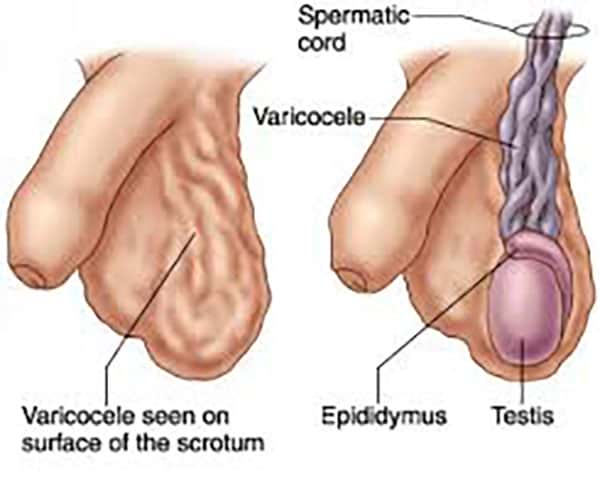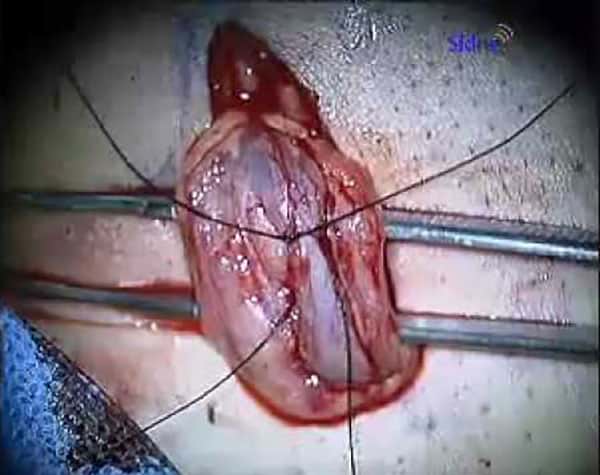What is a varicocele?

A varicocele refers to a collection of abnormally dilated and tortuous veins in the scrotum, which most often occurs on the left side. They can cause discomfort or can be associated with infertility in some men, but often may cause no problems at all.
What does the procedure involve?
Tying or clipping the testicular veins causing the varicocele through an incision in the groin. Dr Nathan uses an operating microscope, which helps identify the testicular veins that need to be ligated and the testicular artery, which should be preserved.
What are the alternatives to this procedure?
Alternatives to this procedure include:
- Observation.
- Radiological embolisation - where coils are used by the radiologist to block off the testicular vein.
- Laparoscopic (keyhole) surgery - more invasive as it is performed through the abdomen but a good option if you have varicoceles in both testicles.
What should I expect before the procedure?
You will usually be admitted to hospital on the same day as your surgery.
You will be asked not to eat and drink for six hours before surgery. Immediately before the operation, the anaesthetist may give you a pre-medication, which will make you dry-mouthed and pleasantly sleepy.
Please tell your surgeon (before your surgery) if you have any of the following:
- An artificial heart valve.
- A coronary artery stent.
- A heart pacemaker or defibrillator.
- An artificial joint.
- An artificial blood-vessel graft.
- A neurosurgical shunt.
- Any other implanted foreign body.
- A regular prescription for a blood thinner e.g. Warfarin, Coumadin Xarelto®, Pradaxa®, Clopidogrel (Plavix®), Brilinta®, or Aspirin.
- Previous or current infection with an antibiotic resistant organism such as MRSA, VRE, etc.
What happens during the procedure?

A full general anaesthetic is normally used and you will be asleep throughout the procedure. You will usually be given an injection of antibiotics before the procedure, after you have been checked for any allergies. The anaesthetist may also use an epidural or spinal anaesthetic to reduce the level of pain afterwards.
The operation is normally performed on the left side where the surgeon will make a small incision in (or just above) the groin. The dilated veins in the scrotum (pictured) arise in the groin where they are tied off.
Absorbable sutures are used which do not require removal.
What happens immediately after the procedure?
You may experience discomfort for a few days after the procedure but we will give you painkillers to take home. Absorbable stitches are normally used and do not require removal.
You will normally go home on the same day as the operation.
Are there any side-effects?
Most procedures have possible side-effects. But, although the complications listed below are well recognised, most patients do not suffer any problems.
- Common (greater than 1 in 10)
- Swelling of the scrotum lasting several days.
- Seepage of yellowish fluid from the wound several days after surgery.
- The external appearance of the varicocele may not change significantly although the symptoms are relieved.
- Late recurrence of the varicocele (in approximately 14%).
- Development of fluid around the testis several months after the procedure (15-30%).
- Occasional (between 1 in 10 and 1 in 50)
- Collection of blood around the testis needing surgical treatment.
- Failure to removal the varicocele completely.
- Rare (less than 1 in 50)
- Damage to or shrinkage of the testicle if the blood supply is affected by the operation.
- Infection of the incision or the testis requiring further treatment.
What should I expect when I get home?
It will be at least 14 days before healing occurs. You may return to work when you are comfortable enough and when your GP is satisfied with your progress. The varicose veins above your left testicle may become slightly more prominent initially because they thrombose after the surgery. Once things have settled, they will become less obvious. Do not, however, expect the veins to disappear completely because they rarely do so
What else should I look out for?
If you develop a temperature, increased redness, throbbing or drainage at the site of the operation, please contact your Urologist or GP.
Disclaimer
This information is intended as a general educational guide and may not apply to your situation. You must not rely on this information as an alternative to consultation with your urologist or other health professional.
Not all potential complications are listed, and you must talk to your urologist about the complications specific to your situation.
